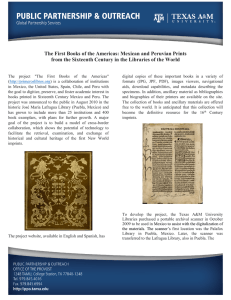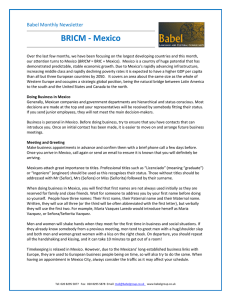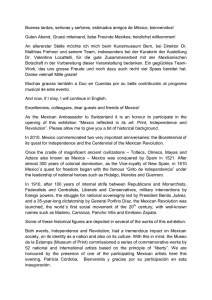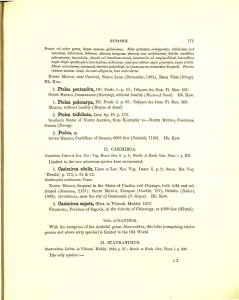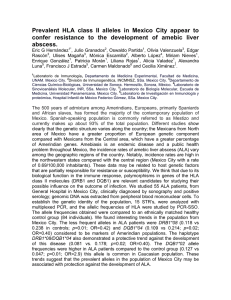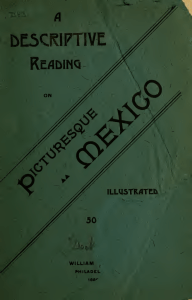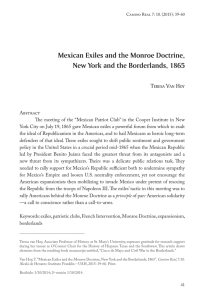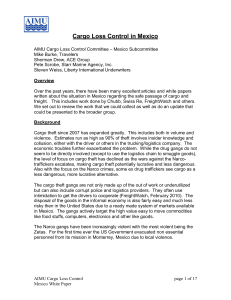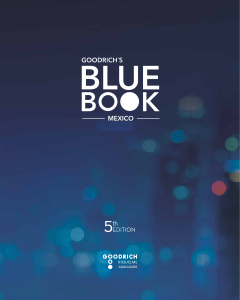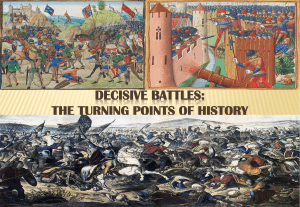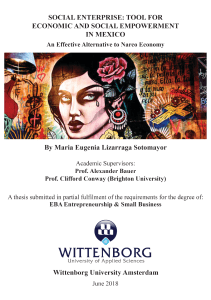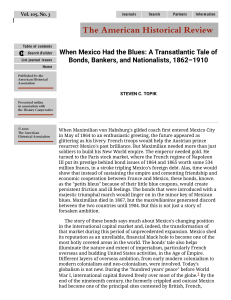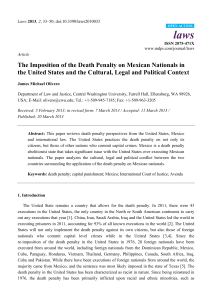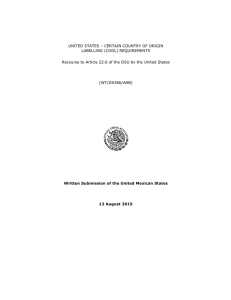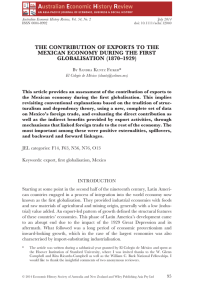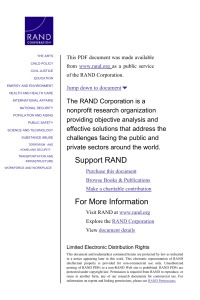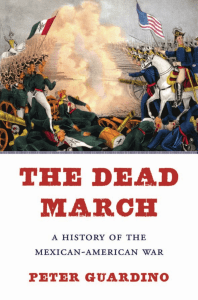Mexico Past and Present - Center for Urban Education
Anuncio
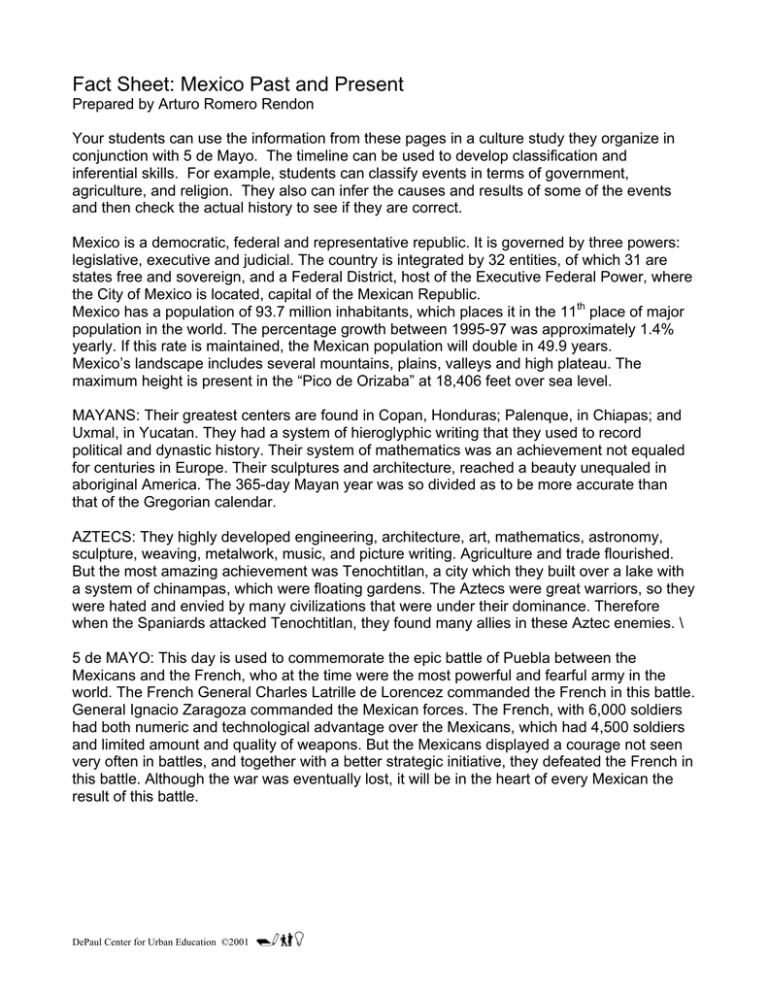
Fact Sheet: Mexico Past and Present Prepared by Arturo Romero Rendon Your students can use the information from these pages in a culture study they organize in conjunction with 5 de Mayo. The timeline can be used to develop classification and inferential skills. For example, students can classify events in terms of government, agriculture, and religion. They also can infer the causes and results of some of the events and then check the actual history to see if they are correct. Mexico is a democratic, federal and representative republic. It is governed by three powers: legislative, executive and judicial. The country is integrated by 32 entities, of which 31 are states free and sovereign, and a Federal District, host of the Executive Federal Power, where the City of Mexico is located, capital of the Mexican Republic. Mexico has a population of 93.7 million inhabitants, which places it in the 11th place of major population in the world. The percentage growth between 1995-97 was approximately 1.4% yearly. If this rate is maintained, the Mexican population will double in 49.9 years. Mexico’s landscape includes several mountains, plains, valleys and high plateau. The maximum height is present in the “Pico de Orizaba” at 18,406 feet over sea level. MAYANS: Their greatest centers are found in Copan, Honduras; Palenque, in Chiapas; and Uxmal, in Yucatan. They had a system of hieroglyphic writing that they used to record political and dynastic history. Their system of mathematics was an achievement not equaled for centuries in Europe. Their sculptures and architecture, reached a beauty unequaled in aboriginal America. The 365-day Mayan year was so divided as to be more accurate than that of the Gregorian calendar. AZTECS: They highly developed engineering, architecture, art, mathematics, astronomy, sculpture, weaving, metalwork, music, and picture writing. Agriculture and trade flourished. But the most amazing achievement was Tenochtitlan, a city which they built over a lake with a system of chinampas, which were floating gardens. The Aztecs were great warriors, so they were hated and envied by many civilizations that were under their dominance. Therefore when the Spaniards attacked Tenochtitlan, they found many allies in these Aztec enemies. \ 5 de MAYO: This day is used to commemorate the epic battle of Puebla between the Mexicans and the French, who at the time were the most powerful and fearful army in the world. The French General Charles Latrille de Lorencez commanded the French in this battle. General Ignacio Zaragoza commanded the Mexican forces. The French, with 6,000 soldiers had both numeric and technological advantage over the Mexicans, which had 4,500 soldiers and limited amount and quality of weapons. But the Mexicans displayed a courage not seen very often in battles, and together with a better strategic initiative, they defeated the French in this battle. Although the war was eventually lost, it will be in the heart of every Mexican the result of this battle. DePaul Center for Urban Education ©2001 Important Events in the History of Mexico 317-987 Old Mayan Empire. 987-1679 New Mayan Empire. 1325 Aztecs or Mexicas establish the city of Tenochtitlan. 1503-1520 Moctezuma II ruled Tenochtitlan. April 22, 1519 Hernan Cortes founded the city of Villa Rica de la Veracruz. August 13, 1521 Hernan Cortes conquers Mexico. 1525 Death of Cuauhtemoc. 1533 Mexico becomes a viceroyalty of New Spain. September 16, 1810 Miguel Hidalgo gives the “Grito de Dolores” and with this, the Independence of Mexico from Spain begins. July 30, 1811 Miguel Hidalgo is captured and shot. February 24, 1821 “Plan de Iguala” by means of this plan, the three fundamental guarantees of Mexicans were recognized: Catholicism, fraternity between Spaniards and Mexicans and political independence. September 27, 1821 Mexico becomes an independent nation. 1822 Iturbide becomes the emperor of Mexico. 1824 First Constitution, which established the country as a Federal Republic. 1824 Guadalupe Victoria became the first president of Mexico. 1829 Vicente Guerrero became president. 1833 Antonio Lopez de Santa Anna took the presidency. 1846 United States of America invades Mexico. 1848 Treaty of Guadalupe Hidalgo, with this treaty, Americans took possession of several Mexican territories. 1853 Santa Anna returns and names himself dictator. 1854 “Plan de Ayutla” which had the purpose of reforming the country. 1855 Ignacio Comonfort beats Santa Anna and forces him to abdicate from power. Comonfort then became the president. 1855 Comonfort ratifies the “Juarez Law” which abolishes military and ecclesiastic jurisdictions;with this, the era of reforms began. 1857 The War of Reform. This war happened because the country was divided in two sides. January 1, 1861 Benito Juarez enters the capital and reestablished national unity. May 5, 1862 Battle of Puebla, where the Mexican forces defeated the French soldiers in the small town of Puebla. 1863 to 1872 Benito Juarez became president of Mexico until his death in 1872. 1872 Lerdo de Tejada succeeds Juarez as president. 1876 to 1911 Porfirio Diaz rules as a dictator. During his mandate the country enjoys a period of tranquility and saw a significant growth in the industry and teaching, although the working class doesn’t see much of an improvement during his rule. 1911 Francisco I. Madero proclaims the “Plan de San Luis” by which he promotes the abolition of reelection and places him as president. 1913 Madero is defeated and Victoriano Huerta takes over the presidency. 1915 Venustiano Carranza becomes president. 1917 Carranza together with the Congress of Queretaro promulgate the Constitution of 1917, which was one of the most advanced at the time. 1934 General Lazaro Cardenas is elected president. During his mandate he aids in the organization of labor unions and elaborates a plan to distribute land amongst peasants. March 18 1938 “Expropiacion Petrolera,” by which Cardenas nationalized the oil industry DePaul Center for Urban Education ©2001

